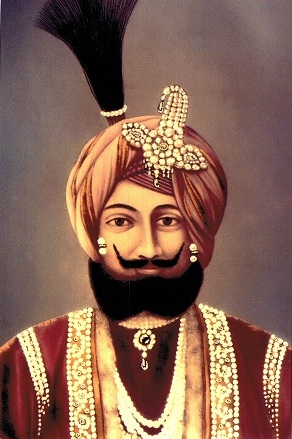Early History of Maharaja Gulab Singh
Maharaja Gulab Singh, the founder of the largest princely state of Jammu and Kashmir was arguably one of the greatest personalities of the 19th century. He became the ruler of modern J & K state in 1846. He was an exceptional warrior, great leader, a brilliant strategist and statesman, and most importantly, the architect of synergetic cultural space in multi-religious state. The history of his life and the contributions that he made in the different realms of Jammu and Kashmir in general and towards restructuring the map of India that we have today in particular has been inspirational.
Gulab Singh and his family were the direct descendants of Raja Dhruv Dev who ruled Jammu in about A.D 1703 to 1733 had four sons Ranjit Dev, Ghansar dev, Surat Singh and Balwant Singh. Surat Singh had two sons, Zorawar Singh and Mian Mota. Zorawar Singh descended Kishore Singh, and from him Gulab Singh, Dhian Singh and Suchet Singh. The three brothers were popularly known as Dogra Brothers or Dogra Trio.
Gulab Singh was born on 21st October 1792 A.D. Early in his childhood he was fully trained in war tactics by his grandfather Zorawar Singh. Later he joined the services of Maharaja Ranjit Singh at Lahore Darbar. Within few years of his recruitment, he led many campaigns for Maharaja Ranjit Singh and played a key role in the consolidation and the management of Sikh kingdom. As a military commander he led following campaigns –
Siege of Kashmir in 1812
Conquest of Jallunder
Conquest of Reasi 1815-16
Frontier campaigns between 1815-19
Conquest of Multan-1819
Conquest of Kisthwar-1821
Gulab Singh earned the title of “Jewel in the Lahore Darbar”.
Raj-Tilak or Sovereignity of Jammu
On June 17, 1822 Maharaja Ranjit Singh bestowed Gulab Singh the title of Raja. Maharaja Ranjit singh personally applied the tilak on his forehead from top to bottom, which was symbolic of the long reign period of the Dogra rulers. The ceremony was performed at Jia Pota tree on the bank of Chenab at Akhnoor.
Expansion of Dogra Raj -
Seige of Samarthan -1824-25
Conquest of Bhimber -1827
Conquest of Peshawar
Conquest of Ladakh 1834
Conquest of Baltistan
Invasion of Tibet
Amritsar Treaty – Raja Gulab Singh became Maharaja on 16th March 1846 AD, when the Treaty of Amritsar was signed and the state of Jammu & Kashmir came into existence.
This was not the end for the Maharaja, rather it was the beginning of another project for him which included the expansion of the boundaries of his state and devising mechanisms to wield the disparate territorial segments of his empire into one political entity. Later his efforts bore fruits and the state earned the title of Darul Aman.
Territorial Expansion and General Zorawar Singh
In the territorial expansion of Maharaja Gulab Singh, Zorawar Singh played a very important role. He was a great military genius, a skilled soldier and commander, who conquered Ladakh, Baltistan and Western Tibet and added about 35,000Km territory to India.
Zorawars Singh was originally from Kahlur in HP, also called Bilaspur. He was born on 13 April 1786. He joined service as a private soldier with the Kiladar of Reasi, as an officer of Maharaja Gulab Singh. The Kiladar frequently sent him as his messenger to Maharaja Gulab Singh. Maharaja Gulab Singh appointed him as inspector of commissariat supplies in all the forts, north of Jammu. In 1820 he was given the title of Wazir by Maharaja Gulab Singh.
When Kishtwar was conquered by Gulab Singh he was appointed as the Governor of Kishtwar. Form here he planned the conquest of Ladakh, Baltistan and Tibet.
Zorawar Singh expanded the Dogra kingdom from the boundaries of Dogra rule from Kishtwar to Central Tibet. He was killed in a battle near Do-Yo in Central Tibet on December 12, 1841. |




